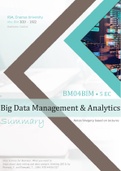Summary
BDMA: Big Data Management & Analytics (BM04BIM) 2021 Summary FULL slides/notes
- Course
- Institution
Contains everything from the Big Data Management & Analytics course. No information is left out, and I've added information from the pre-recorded videos not present on the slides themselves (additional context or explanations). In short: all the relevant info made available in a singular file with ...
[Show more]



